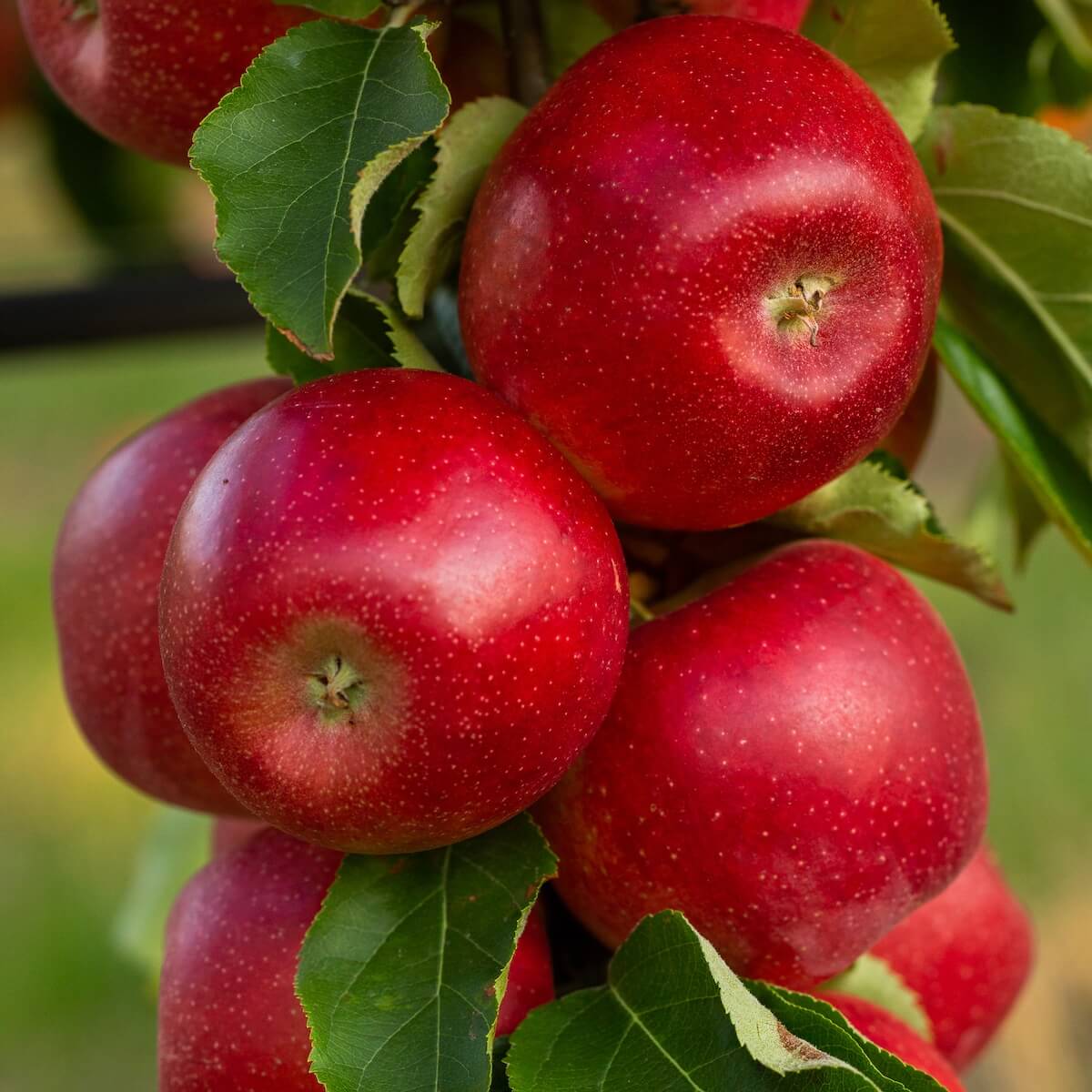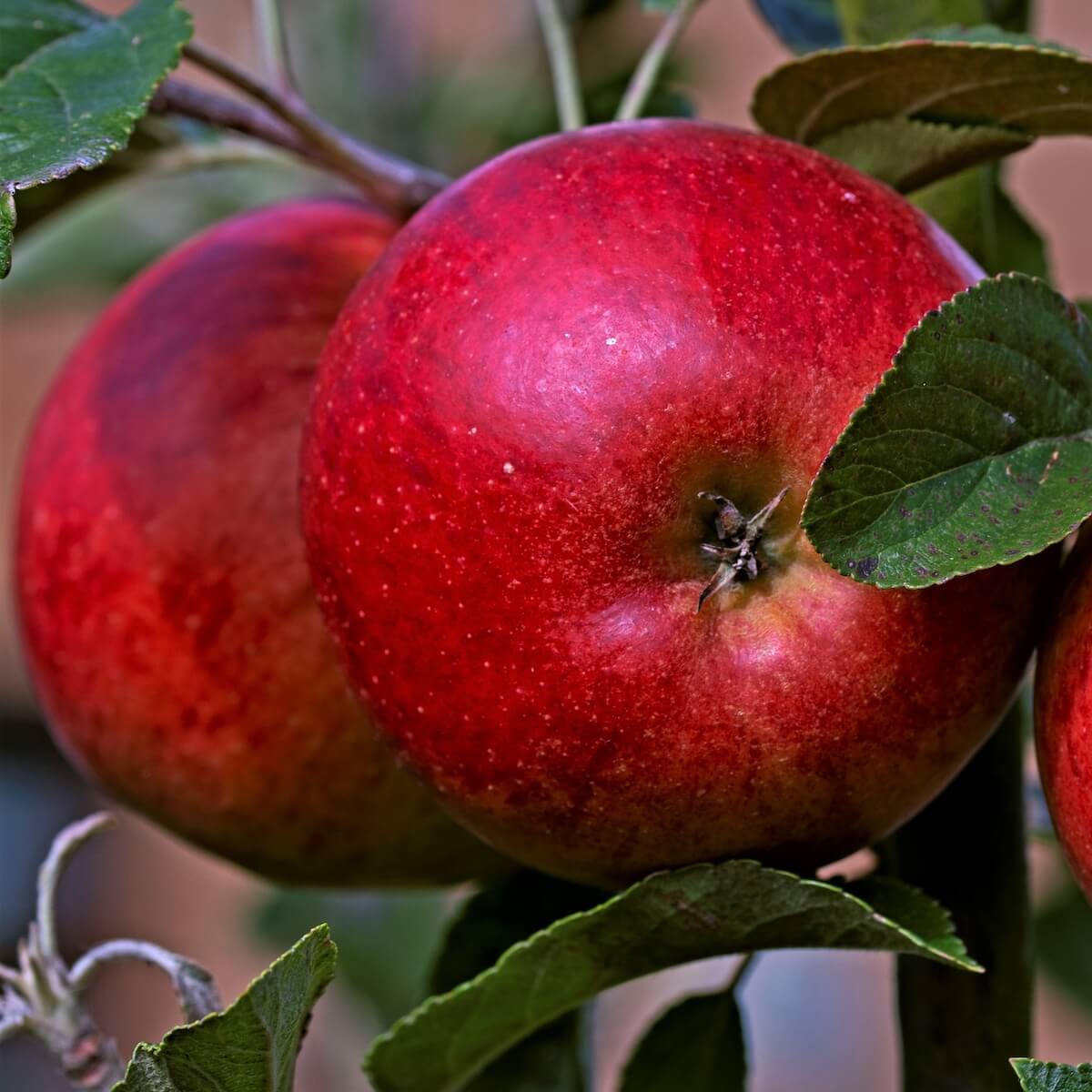
Position
- Full sun to partial shade
- Sheltered from strong winds
- South or south-west facing preferred
- Protected from late frosts
- Good air circulation
Hardiness
- Hardy down to -20°C (-4°F)
- Needs winter chilling for proper fruit development
Soil
- Well-drained, fertile soil
- Tolerates most soil types if well-drained
- Avoid waterlogged conditions
- pH: Neutral to slightly alkaline (6.5-7.5)
- Grab a soil test kit and ensure the perfect conditions for growth
Height
- On M26 rootstock: 2.5-3 metres (8-10 feet)
- On M9 rootstock: 1.8-2.4 metres (6-8 feet)
Seasons of Interest
- Spring flowering: Mid-April
- Pretty pink-white blossom
- Fruit development: July-August
- Harvest period: Late August to early September
- Autumn foliage: Golden yellow
- Early fruiting variety
Additional Notes
- Partially self-fertile but crops better with a pollinator
- Good disease resistance to scab and mildew
- Produces bright red, crisp eating apples
- Excellent choice for children’s gardens due to early cropping
- Fruit stores for up to 6 weeks
- Ideal for small gardens
- Can be trained as espalier or cordon
- Regular pruning is needed in winter
- Good for organic growing
- Reliable and heavy cropping
- Particularly good for northern areas
- Popular variety for juice and fresh eating
Apple Katy - How to Grow This Juicy Red Delight at Home
The Katy apple tree is a fantastic choice for gardeners looking for an easy-to-grow, productive fruit tree with a refreshing flavour. Known for its bright red apples and crisp, juicy texture, this variety is popular among home growers and cider makers. Whether you’re looking for a reliable dessert apple or a fruit perfect for juicing, the Katy apple tree is a rewarding choice. This guide will explore everything you need about growing and caring for this stunning tree.
What Is the Katy Apple Tree?
Apple Katy (Malus domestica ‘Katy’) is a Swedish variety introduced in 1947. It is a cross between the James Grieve and Worcester Pearmain apples, combining the best qualities of both parents. This fruit tree produces attractive medium-sized apples that are usually bright red, with pale cream flesh and a hint of strawberry flavour. The apples are incredibly juicy, ideal for eating fresh, juicing, or making cider.
How to Grow a Katy Apple Tree Successfully?
Growing a Katy apple tree is relatively easy, making it an excellent choice for beginner gardeners. It thrives in well-drained soil and a sheltered, sunny position. Before planting, ensure the ground is moist and free from weeds and grass. Dig a planting hole twice the width of the tree’s root ball and mix in some compost for added nutrients. Once the tree is in place, stake it securely to prevent wind damage and water it well to help establish strong roots.
What Are the Best Conditions for Growing a Katy Apple Tree?
The Katy apple tree performs best in a temperate climate with mild winters and warm summers. It requires a well-drained soil rich in organic matter and benefits from a layer of mulch to retain moisture. Watering is particularly important during dry spells, especially in the first few years after planting. Regular feeding with a balanced fertiliser in early spring will encourage vigorous growth and a heavy crop of apples.

When Does the Katy Apple Tree Produce Fruit?
Katy apples ripen in early September, making them an early-season variety. The fruit is best eaten fresh off the tree, but can also be used to make juice or cider. The apples develop a more intense flavour if left on the tree for as long as possible. However, they do not store well, so they should be enjoyed soon after picking.
How to Prune a Katy Apple Tree?
Pruning is essential for maintaining a healthy and productive apple tree. During the first few years, focus on creating a strong framework of branches. Remove any dead or diseased wood in winter and thin out crowded branches to improve air circulation. If growing the tree as an espalier, regularly trim side shoots to maintain its shape. Katy is a partial tip bearer, so avoid over-pruning, as this could reduce the fruiting potential.
What Are the Pollination Requirements for a Katy Apple Tree?
The Katy apple tree belongs to pollination group 3 and is partially self-fertile, meaning it will produce some fruit on its own. However, planting a suitable pollination partner will improve yield. Good options include James Grieve, Worcester Pearmain, and Orange Pippin. Growing two apple varieties nearby ensures a more reliable crop if space allows. Please check out my article here for more information on Apple pollinating groups.
Is the Katy Apple Tree Suitable for Cider Making?
Yes, the Katy apple is an excellent choice for cider making. Its high juice content and balance of acidity and sweetness create a refreshing cider. Some growers blend Katy apples with sharper varieties to enhance complexity. Whether you prefer a dry or slightly sweet cider, this variety is an excellent addition to any orchard.
Where Can You Buy a Katy Apple Tree?
How to Care for a Katy Apple Tree Throughout the Year?
Caring for a Katy apple tree involves seasonal maintenance:
Spring: Feed with a balanced fertiliser, mulch the base, and check for signs of pests or disease.
Summer: Water during dry spells, thin out excess fruit, and enjoy the attractive blossom.
Autumn: Harvest apples, remove fallen fruit, and start winter pruning.
Winter: Prune to maintain shape, clear debris from around the tree, and protect young trees from frost damage.
From Darren’s Patch
I don’t currently grow Katy in my garden, but I’ve tasted enough to know why it’s such a favourite among home growers. The bright red skin, juicy bite, and that subtle strawberry note make it a real treat straight from the tree. It’s also one of the earliest apples to ripen, a bonus when you’re eager for your first homegrown fruit of the season. I know a few local gardeners who grow Katy on dwarfing rootstocks, and they always speak highly of its reliability and flavour. Katy’s worth considering if you’re looking for an apple that’s easy to grow, great for kids to pick and snack on, and perfect for juicing or even cider. It might just be the next addition to my orchard.
![]()
Key Points to Remember:
- Katy apple trees are easy to grow and highly productive
- The fruit is bright red, juicy, and has a hint of strawberry flavour
- Ideal for eating fresh, juicing, or making cider
- Best grown in well-drained soil in a sunny, sheltered position
- Requires pruning to maintain shape and maximise fruiting potential
- Belongs to pollination group 3 and benefits from a pollination partner
- Available to buy online or from garden nurseries
The Katy apple tree is a fantastic addition to any garden with its trouble-free growth, heavy crops, and excellent flavour. Whether you want a reliable dessert apple or a cider-making favourite, this variety is an excellent choice. Start growing your Katy apple tree today and enjoy delicious homegrown fruit for years!
To see the RHS article, please click here.
Want to learn about other apple varieties? Read about Apple Jonagold here.
For more information on Fruit for your garden, please click here.
Frequently Asked Questions
Q: What is the Katy Apple Tree?
A: Apple Katy (Malus domestica ‘Katy’) is a popular dessert apple variety that is easy to grow and produces juicy, sweet fruit. It is a hybrid of the James Grieve and Worcester Pearmain apples, combining their best traits for flavour and reliable cropping.
Q: When was the Katy Apple first developed?
A: The Katy apple tree was developed in Sweden in 1947. It quickly gained popularity for its excellent flavour, bright red apples, and heavy cropping ability.
Q: How do I pollinate my Katy Apple Tree?
A: Katy apple trees belong to pollination group 3, meaning they benefit from a compatible pollination partner nearby. Good choices include James Grieve or Worcester Pearmain apple trees. Planting one of these nearby will help improve fruit yield.
Q: What do Katy apples taste like?
A: Katy apples have a refreshing, sweet flavour with a slight tang. They are incredibly juicy and have bright red skin, making them delicious and visually appealing. Their crisp texture makes them perfect for snacking and desserts.
Q: Can I grow Katy Apples in my garden?
A: Yes! Katy apple trees are an excellent choice for home gardeners. They are heavy croppers and relatively easy to care for, making them ideal for anyone who grows their own delicious dessert apples.
Q: What is the best way to plant a Katy Apple Tree?
A: To plant a Katy apple tree successfully:
- Choose a sunny spot with well-drained soil.
- If planting a bare-root tree, soak the roots in water for a few hours before planting.
- Ensure adequate spacing from other trees to allow good air circulation.
- Plant near a suitable pollination partner for improved fruiting.
Q: How do I care for my Katy Apple Tree?
A: To keep your Katy apple tree healthy:
- Water regularly, especially during dry spells.
- Feed in early spring with a balanced fruit tree feed.
- Prune annually to maintain shape and encourage vigorous growth.
- Keep an eye out for pests and diseases, using organic treatments where possible.
Q: How long does it take for Katy to produce fruit?
A: Katy apple trees typically bear fruit within 2 to 3 years of planting. With good care, you’ll be enjoying homegrown apples before you know it!
Q: Are Katy apples good for cooking?
A: While Katy apples are best enjoyed fresh, they can also be used in cooking. Their juicy texture and slightly tangy flavour make them suitable for pies and sauces, though they are primarily favoured as an eating apple.
Q: Where can I buy Katy Apple Trees?
A: Katy apple trees are available at garden centres and online retailers specialising in fruit trees. When purchasing, choose a healthy, disease-free tree from a reputable supplier to ensure the best results.
